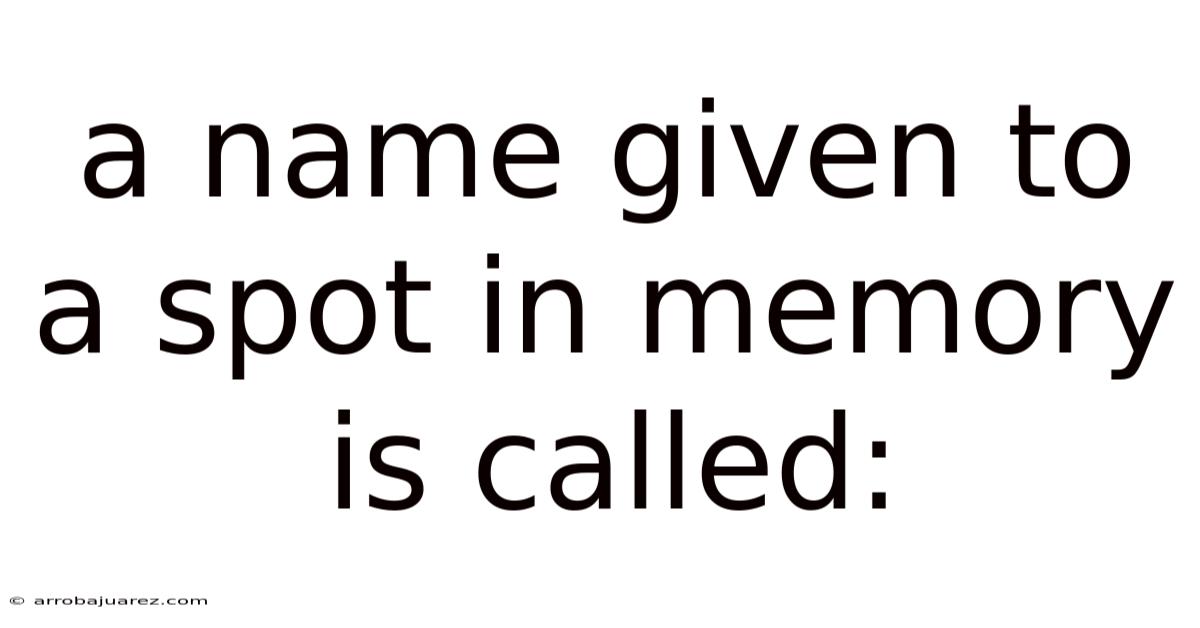A Name Given To A Spot In Memory Is Called:
arrobajuarez
Oct 27, 2025 · 10 min read

Table of Contents
A name given to a spot in memory is called a variable. Variables are fundamental building blocks in programming, acting as labeled storage locations within a computer's memory. They allow us to store, access, and manipulate data during program execution. Understanding variables is crucial for anyone embarking on a journey into the world of coding.
The Essence of Variables
At their core, variables provide a way to associate a meaningful name with a specific memory address. Imagine your computer's memory as a vast warehouse filled with countless storage boxes. Each box has a unique address, but remembering and using these numeric addresses directly would be incredibly cumbersome. Variables solve this problem by giving us the ability to label these boxes with descriptive names, making it much easier to work with the data they contain.
Think of it like this: instead of saying "the value stored at memory address 0x12345678 is 10," you can say "the variable named age stores the value 10." This abstraction significantly simplifies the process of writing and understanding code.
Anatomy of a Variable
A variable typically has three key attributes:
- Name: This is the identifier used to refer to the variable. Good variable names are descriptive and follow specific naming conventions, making the code more readable. For example,
userName,productPrice, andtotalCountare all good variable names. - Data Type: This specifies the kind of data the variable can hold. Common data types include integers (whole numbers), floating-point numbers (decimal numbers), characters (single letters or symbols), and strings (sequences of characters). The data type determines the amount of memory allocated to the variable and the operations that can be performed on it.
- Value: This is the actual data stored in the variable's memory location. The value can be changed during program execution, allowing the variable to represent different data at different times.
Declaration and Initialization
Before you can use a variable, you need to declare it. Declaration involves specifying the variable's name and data type. This tells the compiler to allocate memory for the variable.
Here's an example in C++:
int age; // Declares an integer variable named 'age'
In this example, int specifies the data type (integer), and age is the variable name.
After declaring a variable, you can initialize it, which means assigning an initial value to it.
int age = 25; // Declares an integer variable named 'age' and initializes it to 25
In some programming languages, you can declare and initialize a variable in a single step, as shown above. In other languages, you might need to declare the variable first and then assign a value to it later.
Data Types: A Closer Look
The data type of a variable plays a crucial role in determining how the data is stored and manipulated. Here's a brief overview of some common data types:
- Integer (int): Represents whole numbers without any fractional part. Examples: -10, 0, 25, 1000. Integers are often used for counting, indexing, and representing discrete quantities. Many languages offer different sizes of integers (e.g.,
short,int,long) to accommodate different ranges of values. - Floating-Point Number (float, double): Represents numbers with a fractional part. Examples: -3.14, 0.0, 2.718, 10.5. Floating-point numbers are used for representing real numbers, scientific measurements, and calculations that require precision.
doubletypically offers higher precision thanfloat. - Character (char): Represents a single character, such as a letter, digit, or symbol. Examples: 'a', 'B', '5', '
Latest Posts
Latest Posts
-
Superposition And Reflection Of Pulses Homework Answers
Oct 27, 2025
-
What Is Unique About The Pictured Tissue
Oct 27, 2025
-
A Focus On Customer Orientation Leads To Improved
Oct 27, 2025
-
What Is The Product Of The Hydrogenation Of An Alkene
Oct 27, 2025
-
Which Of The Following Statements About Genes Is Not Correct
Oct 27, 2025
Related Post
Thank you for visiting our website which covers about A Name Given To A Spot In Memory Is Called: . We hope the information provided has been useful to you. Feel free to contact us if you have any questions or need further assistance. See you next time and don't miss to bookmark.